When is an insect pest not a pest for a grower? When it’s not causing economic impact to a crop – until then, it’s just lunch for beneficial insects.
For Northland kumara grower Luke Posthuma, that shift in thinking from seeing every insect pest as a problem to focusing instead on the beneficials to insect pest ratios has been one of the big takeaways from his involvement in the A Lighter Touch (ALT) biodiversity grower champions group.
The group is part of the extension of knowledge and resources from the ALT-Vegetables New Zealand-Onions New Zealand biodiversity project at the Pukekohe Research and Demonstration Farm. It involves growers and advisors from vegetables growing regions around the country who are interested in implementing biodiversity in their farm system as a component of integrated pest management (IPM), who want to help extend knowledge to other growers in their regions.
The group is made up of growers from Northland, Gisborne, Pukekohe, Manawatu and Nelson-Tasman, as well as PGG Wrightson vegetables technical specialist Chris Lambert and LandWISE Sustainable Systems Project Manager Alex Dickson.
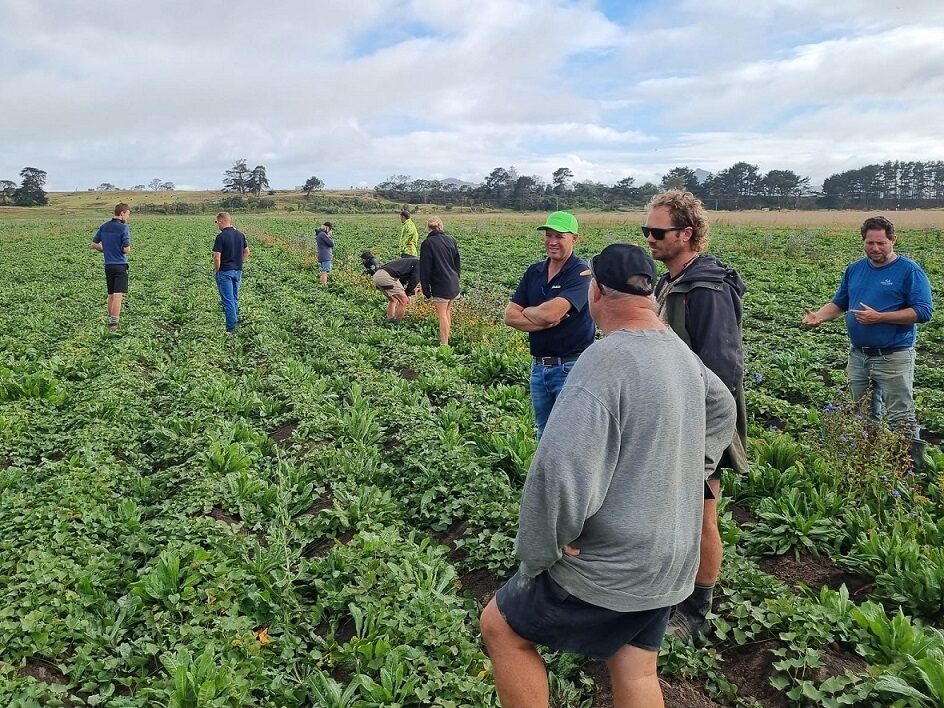
Growers, advisors and others in the industry attend a field day at kumara grower Luke Posthuma’s Northland farm, learning about the use of flower strips to support pest management. Credit: Daniel Sutton
Luke joined the group to learn more about incorporating biodiversity into the farm system to enhance beneficials to assist with pest management, recognising grower practices are changing.
“I’m a young grower, and in 30 years time chemistry will be looking different, the way we grow is going to look different. You’ve got to start learning now and consider the possibilities for how we manage pests in the future.”
He now places greater consideration on his choice of agrichemicals in order to preserve his beneficials. He is also allowing pest caterpillars to grow larger, recognising leaf damage to the canopy is not a concern, it’s only when the pest is of a size that it can move into the kumara tubers that he needs to act.
“Where we were previously spraying every 10-14 days for caterpillar control, now the predators are doing most of our early season control. I’m scouting the crop regularly and I’m proactive. I’m not going to wait until I’m seeing economic damage to the crop, but I now have a good gauge on when I need to act.”
This growing season Luke has trialled annual flower strips to increase biodiversity, and he is considering the use of flowering natives in non-cropped areas and how he can use his fallow ground to encourage more beneficials around the farm in spring, before planting begins in November.
A recognition of the need to move away from agrichemical reliance was also a driver behind Andres Cruz of Woodhaven Gardens in Horowhenua joining the group. Woodhaven Gardens grows and distributes 24 vegetable products nationally.
“We are interested in lowering insecticide spraying and this was a good opportunity to get familiar with flower strips logistics, and the practicalities of how best to incorporate them.”
Woodhaven Gardens has already introduced biodiversity through native plantings in some of their paddocks, and could see the benefit of introducing flower strips for greater biological control.
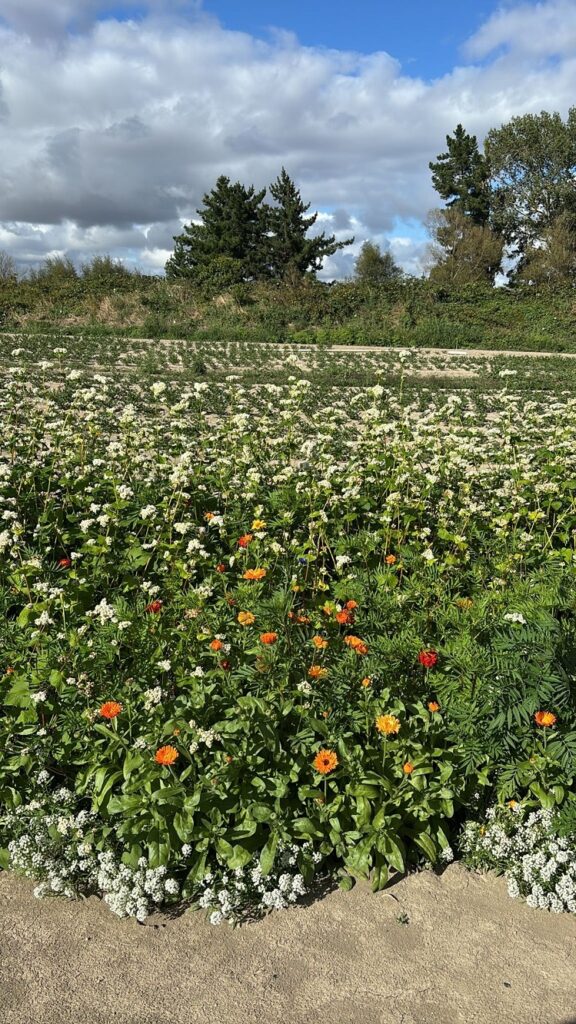
Calendulas and marigolds in full flower in the annual strips at Woodhaven Gardens, with cornflower beginning to blossom. Credit: Andres Cruz.
Andres says they recognise that only relying on chemical control for crop protection will lead to increased resistance, something the sector cannot afford. “Our intention is to farm for many more years to come,” he says.
Karen Silva, of market gardening business Appleby Fresh near Nelson, joined the group to learn how to promote natural pest control through beneficial insects and increase her knowledge of biodiversity-friendly farming. Appleby Fresh also grows a wide range of vegetables, including brassicas, leafy greens and herbs, and a wide range of cucurbits.
She says she has gained insights into attracting beneficials, and implementing eco-friendly pest control strategies, and also values the connections she has made through the group with like-minded individuals keen to share valuable knowledge on creating more sustainable farm systems.”
“It’s amazing to see people from different parts of the country coming together with a shared vision of improving farms, protecting the environment, and ensuring a better future for the next generations. Biodiversity plays such a crucial role in soil health, pest control, and overall farm resilience.”
Karen says lessons learned through the biodiversity project at the demonstration farm has helped fill a knowledge gap. “In terms of biodiversity, there was interest and some knowledge among people, but little understanding of how to increase beneficial insects. There was also very little planning or knowledge about pest and disease control in a friendly and sustainable way.”
Katherine Martin agrees. She has recently joined Perrin Ag Consultants, but was previously with Pukekohe-based growers AS Wilcox. Wilcox’s have a strong focus on sustainability and had previously planted a native regeneration block. This season they have added a native perennial plant strip between the native block and the cropped land to help bring the beneficial predators into the crops.
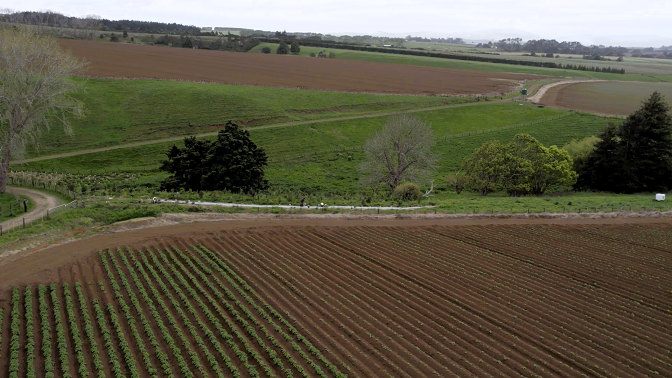
The native perennial plant strip AS Wilcox have planted is located between a native regeneration block and the cropped land. The grey wool mat was used for weed suppression.
“Without the ALT biodiversity group and the resources and knowledge from the project, it probably wouldn’t have been something we looked at or thought was possible, due to not knowing where to start, or how it was providing benefit.
“The A Lighter Touch project is really beneficial for growers because growers are busy people. They don’t have time to research how to plant native IPM strips, or where to plant them, to find out what plants to choose, and what the benefits are.”
Katherine hopes that the knowledge and resource sharing from the project will lead to more growers introducing biodiversity into their farm systems, creating ecological corridors in growing regions which will provide pest management benefits for growers, but will also benefit the environment.
She knows there is still more to learn, but sees ALT playing a key role in bringing all the pieces of the puzzle together, ensuring collaboration and shared resources and knowledge.
“I’ve learned that successful implementation requires time and careful planning, but the results are rewarding. While we may not yet fully understand all the costs, benefits, or ecosystem dynamics, fostering biodiversity to enhance cropping systems ultimately brings significant rewards to growers.”
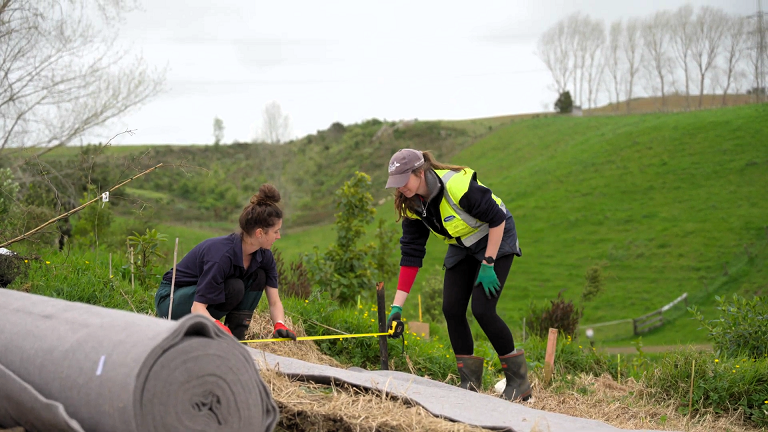
Lauren Wilcox (left) and Katherine Martin measure out the wool mat in preparation for planting the native perennials.
Calvin Gedye, of The Tasty Vege Company, is a third-generation vegetable grower in Gisborne. His father was an early adopter of non-sprayed fence lines and keeping natural barriers around crops, and Calvin himself has learned that a farm system with clear earth and only vegetables isn’t natural, it requires more biodiversity.
Calvin says their growing practices have changed over the years. Where once they would have mowed off a fennel crop that bolted, they now leave it because the flowers provide a food source for beneficials. They also plant the fennel so it can be incorporated into the biodiversity strips once it has been harvested.
He has welcomed the opportunity to learn more through the biodiversity project and the grower group. “Some of the other growers are really advanced with their biodiversity planting, and it’s good to learn what’s working on other farms and how to do it. As a technical farmer, it’s nice to have a plan to follow.”
He says it’s also pleasing to see the rural suppliers responding to the grower interest in biodiverse planting, with some now starting to stock the type of seed required, which was previously difficult to source in commercial volumes.
PGG Wrightson agronomist Chris Lambert, also based in Gisborne, is seeing that increased grower interest from his interactions with growers. He joined the group because he sees promoting biodiversity as “a key piece of the IPM puzzle – the best system we have to manage pests and disease in vegetable crops”.
Having previously trialled (and erred with) biodiversity planting in commercial vegetable crops, he was also keen to share his experience with growers to help them get up and running quickly and avoid similar pitfalls.
Chris says while there is still work to be done in terms of quantifying the effects of beneficials on the crop, they are easy to find in plantings such as annual flower strips, providing background pest management.
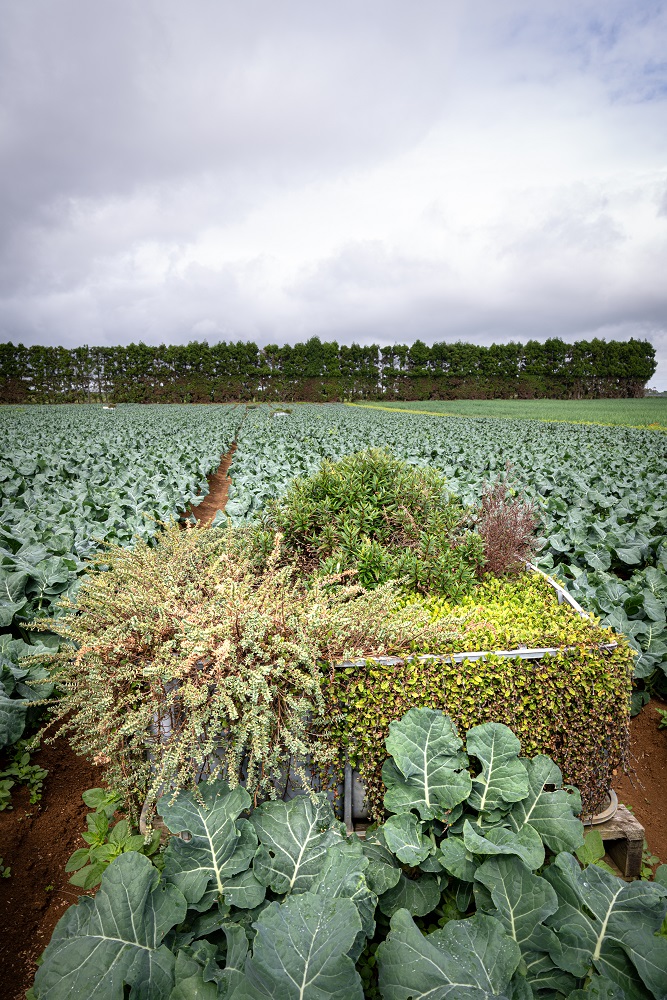
Along with perennial native strips, annual flower strips and cover crops, mobile insectaries are another component of the biodiversity project at the Pukekohe Research and Demonstration Farm.
“There is often a home for these strips on unproductive land such as spray rows and headlands, which doesn’t greatly encroach on cropped areas.”
Chris is keen to understand how far biodiversity seed mixes can be tailored to promote specific beneficial species. “This will be useful if growers are looking to target particular pests rather than general managing background levels of pests.”
The grower group is a key part of the biodiversity project’s extension. The first stage is helping growers integrate knowledge from the project into their own farms. The next stage will involve supporting growers in the group to share their experiences with others in their regions.
Growers interested in learning more about the project, and the group should contact Vegetables New Zealand research, development & extension manager Daniel Sutton.